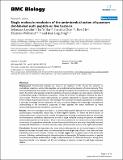| dc.contributor.author | Ding, Jeak Ling | |
| dc.contributor.author | Wohland, Thorsten | |
| dc.contributor.author | Ho, Bow | |
| dc.contributor.author | Har, Jia Yi | |
| dc.contributor.author | Leptihn, Sebastian | |
| dc.contributor.author | Chen, Jianzhu | |
| dc.date.accessioned | 2010-03-11T19:57:52Z | |
| dc.date.available | 2010-03-11T19:57:52Z | |
| dc.date.issued | 2009-05 | |
| dc.date.submitted | 2008-11 | |
| dc.identifier.issn | 1741-7007 | |
| dc.identifier.uri | http://hdl.handle.net/1721.1/52522 | |
| dc.description.abstract | Background: Antimicrobial peptides are found in all kingdoms of life. During the evolution of multicellular organisms, antimicrobial peptides were established as key elements of innate immunity. Most antimicrobial peptides are thought to work by disrupting the integrity of cell membranes, causing pathogen death. As antimicrobial peptides target the membrane structure, pathogens can only acquire resistance by a fundamental change in membrane composition. Hence, the evolution of pathogen resistance has been a slow process. Therefore antimicrobial peptides are valuable alternatives to classical antibiotics against which multiple drug-resistant bacteria have emerged. For potential therapeutic applications as antibiotics a thorough knowledge of their mechanism of action is essential. Despite the increasingly comprehensive understanding of the biochemical properties of these peptides, the actual mechanism by which antimicrobial peptides lyse microbes is controversial.
Results: Here we investigate how Sushi 1, an antimicrobial peptide derived from the horseshoe crab (Carcinoscorpius rotundicauda), induces lysis of Gram-negative bacteria. To follow the entire process of antimicrobial action, we performed a variety of experiments including transmission electron microscopy and fluorescence correlation spectroscopy as well as single molecule tracking of quantum dot-labeled antimicrobial peptides on live bacteria. Since in vitro measurements do not necessarily correlate with the in vivo action of a peptide we developed a novel fluorescent live bacteria lysis assay. Using fully functional nanoparticle-labeled Sushi 1, we observed the process of antimicrobial action at the single-molecule level.
Conclusion: Recently the hypothesis that many antimicrobial peptides act on internal targets to kill the bacterium has been discussed. Here, we demonstrate that the target sites of Sushi 1 are outer and inner membranes and are not cytosolic. Further, our findings suggest four successive steps of the bactericidal process: 1) Binding, mediated mainly by charged residues in the peptide; 2) Peptide association, as peptide concentration increases evidenced by a change in diffusive behavior; 3) Membrane disruption, during which lipopolysaccharide is not released; and 4) Lysis, by leakage of cytosolic content through large membrane defects. | en |
| dc.description.sponsorship | Singapore-MIT Alliance (SMA II, Computation and Systems Biology, FRP: Immunology & Tissue Defense) | en |
| dc.description.sponsorship | Singapore Bioimaging Consortium (SBIC 003/2005: R-143-000-284-305) | en |
| dc.language.iso | en_US | |
| dc.publisher | BioMed Central | en |
| dc.relation.isversionof | http://dx.doi.org/10.1186/1741-7007-7-22 | en |
| dc.rights | Creative Commons Attribution | en |
| dc.rights.uri | http://creativecommons.org/licenses/by/2.0/ | en |
| dc.source | BioMed Central | en |
| dc.title | Single molecule resolution of the antimicrobial action of quantum dot-labeled sushi peptide on live bacteria | en |
| dc.type | Article | en |
| dc.identifier.citation | Leptihn, Sebastian et al. “Single molecule resolution of the antimicrobial action of quantum dot-labeled sushi peptide on live bacteria.” BMC Biology 7.1 (2009): 22. | en |
| dc.contributor.department | Massachusetts Institute of Technology. Department of Biology | en_US |
| dc.contributor.department | Koch Institute for Integrative Cancer Research at MIT | en_US |
| dc.contributor.approver | Chen, Jianzhu | |
| dc.contributor.mitauthor | Chen, Jianzhu | |
| dc.relation.journal | BMC Biology | en |
| dc.eprint.version | Final published version | en |
| dc.type.uri | http://purl.org/eprint/type/JournalArticle | en |
| eprint.status | http://purl.org/eprint/status/PeerReviewed | en |
| dspace.orderedauthors | Leptihn, Sebastian; Har, Jia; Chen, Jianzhu; Ho, Bow; Wohland, Thorsten; Ding, Jeak | en |
| dc.identifier.orcid | https://orcid.org/0000-0002-5687-6154 | |
| mit.license | PUBLISHER_CC | en |
| mit.metadata.status | Complete | |
